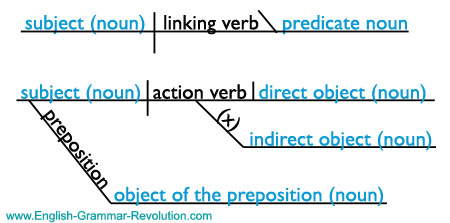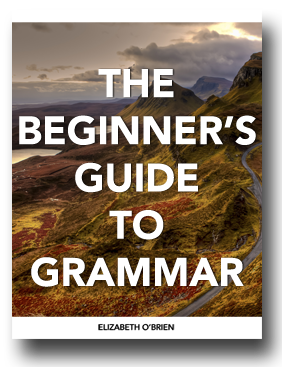Download your free grammar guide here.
Download your free grammar guide here.
What is a direct object?
What is a direct object?
- Home
- Parts of Speech
- Nouns
- Direct Objects
Are you familiar with direct objects? You will be by the end of this lesson! (Be sure to take the quiz at the bottom of this page.)
Before we dive into the wonderful world of direct objects, you need to have a little lesson on action verbs. (Verbs are words that show action or states of being. They are one of the parts of speech.)
Some action verbs don't use any other words to complete their meaning.
The book fell.
The flower bloomed.
Some action verbs do use other words to complete their meaning.
The boy kicked the ball.
Alice poured lemonade.
Do you see how ball and lemonade complete the meaning of the verbs kicked and poured?
Words that complete the meaning of action verbs like this are called direct objects.
The type of verbs that need direct objects to complete their meaning are called transitive active verbs. These verbs transfer their action to the direct object. (Check out the page on action verbs to learn more about this verb type.)
To find the direct object in a sentence, ask this question.
What/Whom did the (subject) (verb)?
When we fill in the blanks for those example sentences above, our question becomes...
What did the boy kick?
What did Alice pour?
The answers are ball and lemonade. Voila! We have our direct objects. Wasn't that easy?
The Direct Object Question At Work
I'm going to quiz you with two sentences now. Are you ready? Good! Use the direct object question to find the direct objects in the following two sentences.
1. Daniel drew a picture.
Fill in the blanks from our question. --> What did Daniel draw? He drew a picture, and picture is the direct object. That means that drew is a transitive active verb in that sentence.
2. Mike ran across the field.
Fill in the blanks from our question. --> What did Mike run? What's the answer? Are you scratching your head? This sentence doesn't have an answer to the direct object question. That means there's no direct object in this sentence!
Remember that not every sentence has a direct object. You'll only find them in sentences that have transitive active verbs. In this sentence, the verb ran is an intransitive complete verb, and that kind of verb isn't accompanied by a direct object.
Sentence Diagramming & Direct Objects
Have you diagrammed sentences before? It's really fun, and it's a great way to make grammar visual. DOs are diagrammed on the same horizontal line as the subject and the verb.
Put a vertical line between the verb and the DO, but be sure that the line doesn't go below the horizontal line.

Elizabeth read the newspaper.
Learn more about diagramming direct objects with these exercises.
What part of speech is a direct object?
If you've been studying grammar for a little while, you know that all of the words that we use can be grouped into categories that we call the parts of speech. Here are the parts of speech: nouns, pronouns, verbs, adverbs, adjectives, conjunctions, prepositions, and interjections.
Did you notice something fishy?
There is no category called direct objects.
What's going on here?
While direct objects are not one of the parts of speech, only certain parts of speech can function as direct objects. Based on the direct objects that you've seen so far in this lesson (ball, lemonade, picture, and newspaper), would you like to guess which parts of speech can be direct objects?
Here's the answer: nouns and pronouns!
Nouns are words that name people, places, things, or ideas. They are a bit strange because they perform different jobs in our sentences. Nouns can be subjects, direct objects, indirect objects, objects of prepositions, objective complements, and more.
Pronouns are words that take the place of nouns. They can do anything that nouns can do.
Here's a sentence diagram showing you some of the noun jobs. Nouns do a lot in our sentences!

It's your turn!
What did the (subject) (verb)?
Directions: Find the verbs and direct objects in the following sentences. Do you think you can do it? Of course you can! Some of the sentences might not have direct objects, so stay on your toes. You'll find the answers right below these questions.
1. The dog ate my homework.
2. My neighbor's tree fell during the storm.
3. Our amazing soccer team won the trophy!
4. I love my friendly neighborhood.
5. Sam and Ava raked leaves yesterday.
6. The couple swayed with the music.
7. Your new dress is stunning.
8. The sick teacher sipped tea.
9. My dad built a loft for my bed.
10. I took a deep breath.

Answers
The transitive active verbs are in bold and the direct objects are underlined.
1. The dog ate my homework.
2. My neighbor's tree fell during the storm. NO DO
3. Our amazing soccer team won the trophy!
4. I love my friendly neighborhood.
5. Sam and Ava raked leaves yesterday.
6. The couple swayed with the music. NO DO
7. Your new dress is stunning. NO DO
8. The sick teacher sipped tea.
9. My dad built a loft for my bed.
10. I took a deep breath.
How did that go? I hope that this lesson helped you learn more about how English grammar works.
If you'd like to teach or learn grammar the easy way—with sentence diagrams—check out our Get Smart Grammar Program.
It starts from the very beginning and teaches you grammar and sentence diagramming in easy, bite-size lessons.
This is original content from https://www.english-grammar-revolution.com/direct-object.html

Hello! I'm Elizabeth O'Brien, and my goal is to get you jazzed about grammar.
Our Free Guide Gives You A Fun Way
To Teach And Learn The Basics v

Elizabeth O'Brien is the creator of Grammar Revolution.
Her lessons are guaranteed to give you more confidence in your communication skills and make you smile. :)
Other Helpful Resources
- This PDF gives you 18 sentences that will test your knowledge, and it also gives you the answers. Yay!

